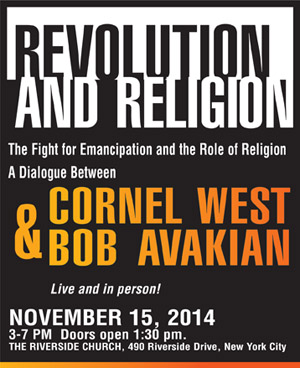You Have a Chance to See “The Jimi Hendrix of Revolution.” Live.
October 9, 2014 | Revolution Newspaper | revcom.us
From a young revolutionary:
November 15, 2014. Riverside Church. New York City. “Revolution and Religion: The Fight for Emancipation and the Role of Religion.” Bob Avakian, the chairman of the Revolutionary Communist Party and leader of a new stage of communist revolution, in dialogue with Cornel West, fellow champion of the oppressed and one of the most provocative public intellectuals of our time.
There are several reasons why this Dialogue will be, to put it quite simply, a historic and extraordinary event that is not to be missed. Here, I want to speak briefly to one of those reasons—and it’s huge: the opportunity to see Bob Avakian, live and in person.
In thinking about what this opportunity means, and how to drive this home, I was reflecting on my passion for music, and live music in particular. Sometimes, for fun, I think—and talk with friends and loved ones about— all the great musical artists of the past 50 years or so, and who among them I would give anything to see live. Sometimes, the discussion turns to whom I would most like to—but sadly never will get the chance to—see in concert. I always come up with the same name at the top of that list: Jimi Hendrix.
People who are expert musicians, or who know more about the technical aspects of guitar-playing, could no doubt write very insightful and compelling explanations of what set Jimi Hendrix apart in that regard. I just know that he played unlike anyone else, before or since. Of course, he was influenced by those who came before him – Robert Johnson, Chuck Berry, and Buddy Guy, to name just a few. But Jimi was just on a whole other level. He did things on the guitar that no one else had done. There was not just music coming from his guitar: there was truly unique poetry and beauty and emotion. Anyone who wants to—or at least deserves to—be taken seriously as a guitarist is deeply familiar with, and studies, Hendrix and his work. And Jimi also connected with, and profoundly inspired, his audience in a way that they did not just hear his music but could feel it.
I highly doubt that very many people lucky enough to see Jimi live said: “Well, okay, I’ve seen him live. No point in listening to his albums anymore.” On the contrary, I would imagine that people who saw him in concert left with a feeling of being on fire to get into—or deeper into—his albums. On the flip side, it is difficult to think that anyone who knew about Hendrix and had the actual opportunity to see him live said: “No, that’s okay. I’ll just listen to his albums.”
On November 15 at Riverside Church in New York City, you have a chance to see the Jimi Hendrix of revolution: Bob Avakian.
Bob Avakian (BA) was also heavily influenced by—and has gone forward on the foundation of—those who came before him. Most notably: Marx, Lenin, and Mao. But BA, too, is unlike anyone else, before or since. When it comes to the science of revolution and communism—of how humanity can get free—BA has done things that no one else has done before. Specifically, he has done the work that no one else has done and made breakthroughs that no one else has made on the biggest questions bound up with human emancipation. Anyone who wishes to be taken seriously when it comes to radically changing the world needs to study, and learn all they can from, BA’s work. BA has brought forward a new synthesis of communism—the theory, method, strategy and vision for how, through revolution, humanity could overcome thousands of years of brutal exploitation and oppressive divisions between people. This new synthesis provides the framework to bring into being a society and world where people’s basic needs are met, where people relate to each other in a completely different way, where society is alive and pulsing with wide-ranging intellectual, scientific and artistic exploration and revolutionary joy, and where humanity as a whole works together for the common good and works to protect the planet. And BA is leading a party and a movement for revolution on the basis of this new synthesis that he has brought forward.
BA will be bringing all of that to the Dialogue with Cornel West at Riverside Church on November 15. But that isn’t all. He will also be bringing the experience of BA speaking, live and in person.
Like Jimi Hendrix, BA connects with and profoundly inspires his audience in a way that people do not simply hear but viscerally feel. It’s in the way he continuously lays reality bare, fearlessly exposing this system and society—and everything that keeps them going—unearthing and boldly putting forward the truths that are hidden and that people are not allowed to think and say. It’s in the way he rips the mask of legitimacy and permanence off the existing order, dismantling any notion that things have to stay as they are, lifting hearts and sights to a whole different way the world could be. It’s in the way BA does all this with rage and joy, humor and defiance, passion and poetic spirit, utter contempt for the system and those who rule it and deep compassion for all those who can and must be part of the fight to sweep that system away, especially those on the very bottom of society who are most viciously oppressed. It’s in the way he breaks concepts down so that a professor with a Ph.D. or someone without any formal education can understand and take up these concepts. It’s in the method with which he approaches reality, always going for the truth, always looking at things scientifically. It’s in the way he illuminates the link between where we are today and where we can and must go tomorrow, and speaks to the biggest obstacles and contradictions standing in the way. It’s in the way he ranges very broadly, through different spheres of society and different historical eras, without ever losing the core of revolution and communism. It’s in the way he weaves so many different threads together. It’s in the way he can break down the strategy for revolution or talk about the historical experience of communism in one moment, and then reference lyrics from The Clash or routines from Richard Pryor the next.
As with Jimi Hendrix, there is a total synergy, not an opposition, between the opportunity to see BA live and in person and the importance of studying his works in an ongoing way. Failing to fully recognize the incredibly special and unique opportunity to see BA live and in person because one is already familiar with BA’s works would make no more sense than people failing to recognize how special it would have been to see Hendrix live and in person because they already were familiar with his albums. Similarly, people who do see BA live and in person should only leave the room even more determined and inspired to dig into his works.
I’ll end on this point: With Hendrix, one could definitely have explained what set him apart and what made him and his work so special, and that was certainly worthwhile and important to do. But at a certain point, people simply had to wake up and realize—and make the decision—that they better go see for themselves.
The same is true with the opportunity to see BA live and in person. There is a lot that can, and should, be said about what sets BA apart, and what makes him and his work so special. But then, at a certain point, you just have to wake up and realize that you need to go see for yourself.
You have this opportunity at Riverside Church, in New York City, on November 15. Don’t miss the chance!
Volunteers Needed... for revcom.us and Revolution
If you like this article, subscribe, donate to and sustain Revolution newspaper.



